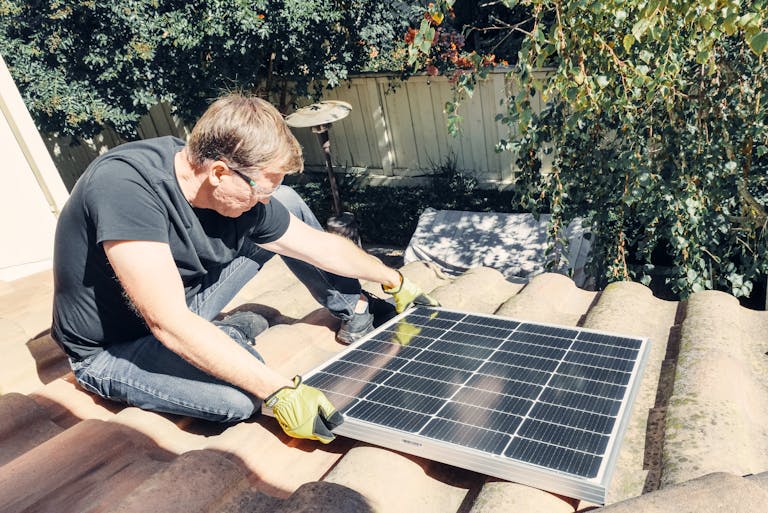Camping with solar power opens up a world of eco-friendly and self-sufficient adventures. Whether a novice or a seasoned camper, setting up solar power for outdoor excursions can enhance your experience while reducing your environmental footprint. So, how to set up solar for camping?
How To Set Up Solar For Camping | Step-By-Step Guide
So, how to set up solar for camping? I’ll walk you through harnessing solar energy for your camping needs, from estimating power requirements to enjoying the benefits of free, renewable energy.
Step 1. Estimate Your Power Needs
Consider all the appliances and devices you plan to use during your camping adventure. Once you have a comprehensive list, you can proceed with quick and straightforward calculations to determine your energy consumption in kilowatt-hours (kWh).
For instance, let’s say you’re bringing lighting fixtures with you on your trip. To calculate the energy your lights will consume each day, multiply the combined wattage of your lighting system by the number of hours you anticipate using it. Then, divide the total by 1000 using the following formula:
kWh = (watts x hours) / 1000
A kilowatt (kW) equals 1000 watts of power, while a kilowatt-hour represents the energy consumption of 1000 watts over one hour.
Additionally, it’s essential to consider surge watts if applicable. Surge power refers to the extra electricity required to start an appliance initially. Many devices experience a brief surge in power demand when powered on for the first time. You can calculate surge watts using the formula:
Watts = Volts x Amps
Typically, surge watts are estimated to be 1-2 times the running wattage, usually specified on the appliance. Taking surge watts into account ensures that your solar power system can handle the initial power demands of your devices effectively.
Step 2. Selecting the Perfect Campsite
Choosing the right campsite is essential for maximizing solar power efficiency. Whether camping in an RV or setting up a tent, selecting a location with ample sunlight is key.
For RV campers, parking in a non-shaded area allows for optimal positioning of fixed solar panels. Meanwhile, portable solar panels offer flexibility, allowing you to adjust their position throughout the day to capture maximum sunlight.
Step 3. Choosing Your Components
Building a functional solar power system for camping requires several essential components:
I. Solar Panels
Selecting the appropriate solar panels depends on your power requirements and setup preferences. Options include rigid panels for fixed installations on RVs or flexible panels for portable setups.
II. Solar Battery
Choosing the right battery capacity is crucial for storing solar energy to power your devices and appliances during periods of low sunlight. Consider factors like battery capacity, voltage, and chemistry when selecting your battery.
III. Inverter
An inverter is necessary for converting the DC power generated by your solar panels into AC power compatible with your camping appliances.
IV. Solar Regulator
Also known as a charge controller, a solar regulator regulates the voltage and current from your solar panels to prevent overcharging and damage to your battery.
Step 4. Constructing a Battery Enclosure
Building or purchasing a sturdy battery enclosure is essential for protecting your batteries from the elements and ensuring safety, especially in family camping. Adequate ventilation and temperature control are critical for maintaining battery health and safety.
Step 5. Installing Your Solar Panels
The installation process varies depending on whether you opt for fixed or portable solar panels. For fixed installations, ensure proper mounting and orientation of your panels to maximize sunlight exposure. Portable panels offer flexibility and can be positioned on the ground or other surfaces to capture sunlight.
Step 6. Wiring Your Solar Power System
Wiring your solar power system requires careful planning and adherence to safety guidelines. Ensure compatibility between components and follow manufacturer instructions for proper installation. To maximize efficiency, consider optimal wiring configurations, such as series connections for multiple panels.
Step 7. Embracing Free Power
With your solar power system successfully set up, you can enjoy the benefits of free, renewable energy on your camping adventures.
Solar power saves money and reduces environmental impact, offering a sustainable alternative to traditional power sources. Embrace the freedom and sustainability of solar energy as you explore the great outdoors. Now you know the answer – how to set up solar for camping?
Conclusion
Setting up solar power for camping is a rewarding endeavor with practical and environmental benefits. By estimating your power needs, selecting the right components, and following best practices for installation and wiring, you can enjoy the convenience and sustainability of solar energy on your outdoor adventures.
Harness the sun’s power and elevate your camping experience with solar power. I hope now you know, how to set up solar for camping?
Some of the links in this post are affiliate links. This means if you click a link and make a purchase we will receive an affiliate commission at no extra cost to you.
